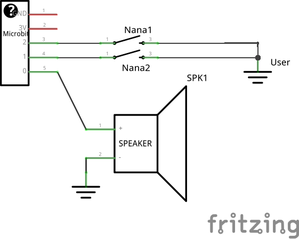Go bananas with the BBC Micro Bit
Posted on Fri 05 August 2016 in microbit
I received the microbit a couple of weeks ago and it's a solid device with plenty of scope for fun times. The best thing is that it runs micropython. Yey, go team!
I had a chance for a quick play with the microbit during the butlins science weekend. The weekend was awesome and I can't recommend it enough!
One of the displays my son really enjoyed was the banana piano. There were about 5 bananas on display. You hold the ground wire and are then able to tap out a tune on the bananas with your other hand. I think they were using the Makey Makey.
After the holiday, I had to wait for a couple of months for the microbit to be released to the public. The microbit doesn't just plug into a breadboard, so I ordered some crocodile clips from aliexpress.
Eventually it arrived in the post and I got to playing with it.
I struggled with the web ui. It's ok, but to save your code you need a school account and it didn't seem set up for the public.
Then I found the mu editor. This allows you to work on code locally and upload them to the microbit. It is a simple editor and the developers have gone to great lengths to keep it simple. This means some things are missing that I use in my normal workflow. We can't have everything and I can dream that someday there will be a sublime text plugin.
Anyways, it is a good editor and supports things like syntax highlighting and pep8 linting etc.
The basic process is:
- Plug microbit into computer.
- Enter code into editor and save file.
- Press the flash button.
- Code is compiled and uploaded to microbit.
- Code runs on microbit (or maybe an error message).
Sometimes the microbit can't be seen (I'm running Xubuntu). When I click on the flash button, I need to select the device in the folders menu and then retry the flashing.
Banana Piano
I built a couple of scripts whilst I was playing around with the microbit. Once I was comfortable with the microbit it was time to recreate the banana piano!
Bananas are the real musical fruit #microbit #micropython pic.twitter.com/jpufzOidJ8
— Gary Bake (@MrGaryBake) July 25, 2016
There are 3 outputs big enough for the crocodile clips. We are using one for the buzzer, so we have 2 left to use as switches; hence only 2 notes.
But more than enough to play Happy Birthday!

I couldn't find a fritzing pic of the micropython. Even worse - I don't think there is an official circuit symbol for banana!
Micropython
I modified code from the is_touched() function in the micropython docs.
from microbit import *
import music
note_low = ["C4:4"]
note_high = ["C5:4"]
while True:
if pin1.is_touched():
music.play(note_low)
display.show(Image.HAPPY)
elif pin2.is_touched():
music.play(note_high)
display.show(Image.SURPRISED)
else:
display.show(Image.SAD)
We create 2 notes - in fact we create two tunes of one note each, hence the array notation.
Looping forever, the code checks to see if a pin/banana is touched and changes the screen/plays the note accordingly.
Pretty smart stuff :)